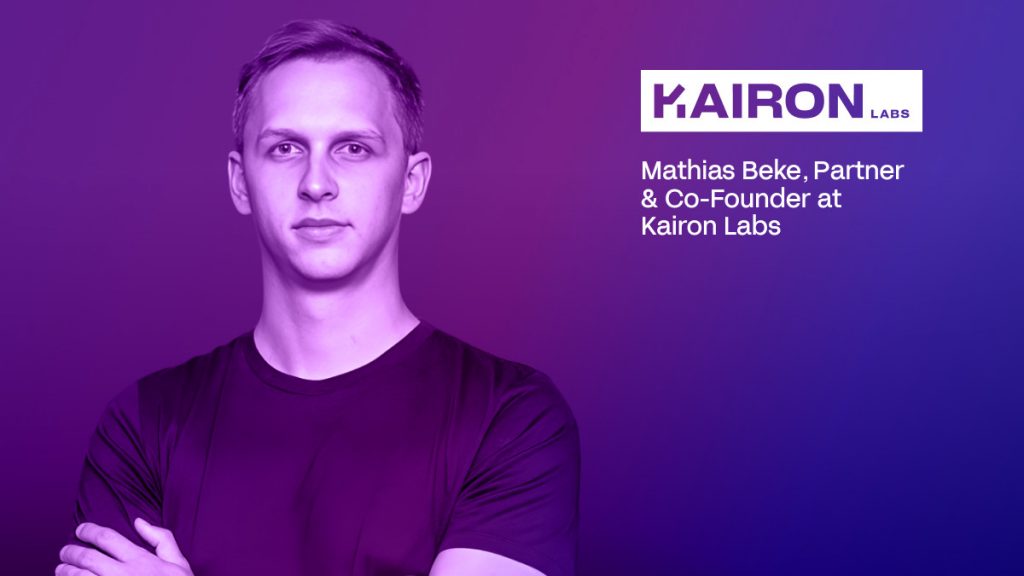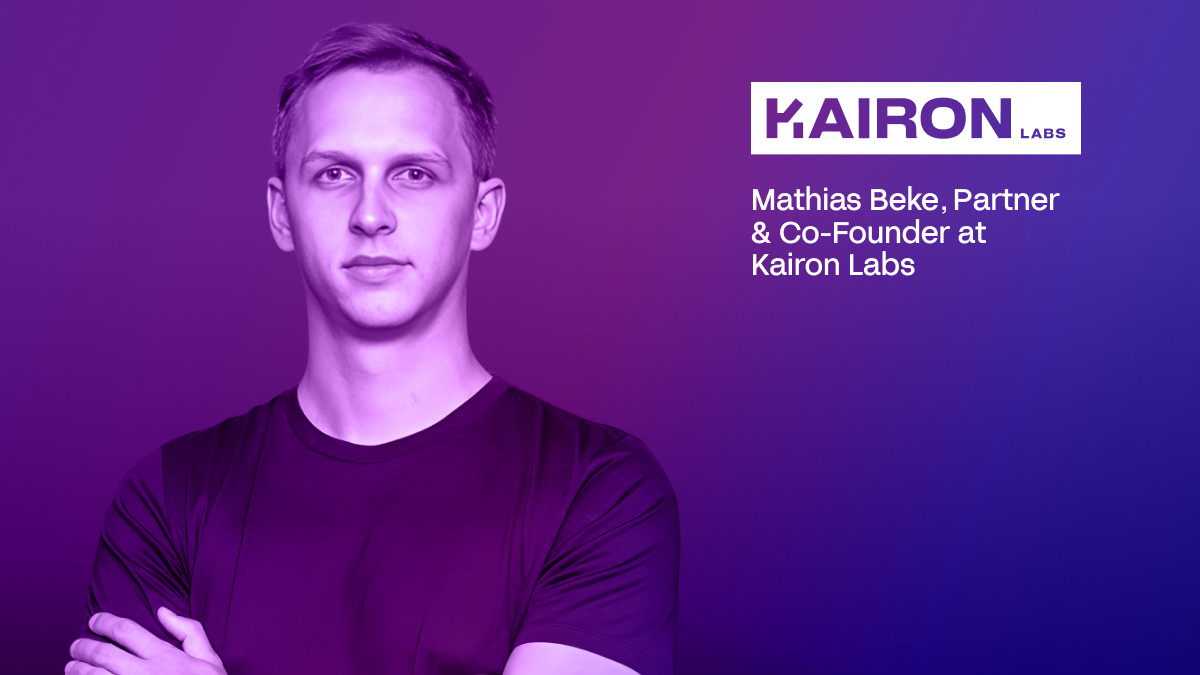

In Brief
Mathias Beke, Partner & Co-Founder at Kairon Labs, shares his experience in the crypto market, focusing on ethical practices and technological innovations in liquidity provision.

In this interview, Mathias Beke, Partner & Co-Founder at Kairon Labs, shares his journey from traditional finance to the crypto market making. With over a decade of experience and a keen eye for market inefficiencies, Beke offers a unique perspective on the challenges and opportunities in the rapidly evolving cryptocurrency landscape. From ethical practices to technological innovations, he provides a comprehensive look into the intricacies of liquidity provision in both bull and bear markets.
Can you elaborate on your journey to Web3?
I started working in traditional finance 12 years ago as an engineer in the engineering department of a bank in Belgium. In 2016, I was already investing a bit in crypto as a retail investor. In 2017, I decided to quit my job in traditional finance and fully focus on web3, mainly because I was interested in trading activities and saw a lot of inefficiencies in the market.
My current co-founder and I, together with somebody else we know, started investing in projects and advising projects. We kept seeing that market making was something that had a high necessity in crypto, and there were so many inefficiencies that we decided to fully focus on market making. That happened in 2019.
The last part of 2019 is when the actual market really started. It was a pretty tough ride for us, but we kept on building Kairon Labs and kept focusing on market making and helping token projects provide quality and launch into the market. We kept scaling Kairon Labs, and today we’re around 50 people. Our focus is still on providing liquidity and making sure we support token projects in launching their tokens on different exchanges and providing liquidity for them.
How do you ensure ethical market-making practices while still meeting the liquidity needs of emerging crypto projects?
First, we need to define what ethical market making is. In my opinion, ethical market making involves providing orders that others can execute and ensuring the avoidance of unethical practices. For example, in traditional finance, wash trading is considered illegal, so we apply the same standards. Spoofing or taking orders is also considered illegal, so it’s something we don’t do.
Ethical market making is crucial, and then secondly, no matter what the market is, you need to provide that liquidity. Whether it’s for high-volume tokens like BTC and Ethereum or smaller coins, for us, it’s almost exactly the same. Obviously, the more traded coins have more counterparties, so it makes trading simpler for us but more competitive, while lower traded coins are less competitive but more complex.
Being ethical throughout the chain is crucial, and making sure that you apply those practices throughout the cycle is essential.
Do you have different market-making strategies for bull and bear markets?
The strategies themselves are more or less the same. What you see in a bear market is that the inefficiencies are less apparent and also less available to trade on. It’s pretty hard at that point to take opportunities, so that is a difficult thing in a bear market. There are fewer opportunities because there’s less volume, and the more volume there is, the more opportunities there are, the more volatility there is – it’s like a snowball effect.
In a bear market, we use those times to enhance the strategies, improve strategies, and do research on the strategies. You don’t have time in bull markets to do that. In bull markets, there are a lot of inefficiencies, which is great, but then you see smaller players coming back in and starting to trade, so the competition is a bit higher.
Our strategies remain the same, and it’s about understanding the market so that you can configure the algorithms properly and provide liquidity. During extreme market events, it’s crucial to have your algorithms in circuit breaker mode and ensure your portfolio risk is managed. So you’re a bit more cautious of these things, and they’re really enhanced in our systems.
Is your approach different for various crypto assets?
It is different. For example, stablecoins are a whole different type of liquidity provision, so you need to stay in the peg. That’s not really something we focus on unless there are inefficiencies.
For DeFi coins, in a lot of cases, the liquidity is on decentralized exchanges, so the opportunities and the counterparties are on-chain and not off-chain. Your algorithms need to source the liquidity or your counterparties on a different level.
For layer-one tokens, you often need to source liquidity on their native chain. So technology-wise, you need to integrate with those chains and be prepared to find counterparties there. It’s more about the technology stack and which type of protocols you’re integrating with.
How are market makers addressing the challenges of providing liquidity for cross-chain assets and interoperability protocols?
That’s one of our biggest challenges. When we go to on-chain liquidity provision, especially on mature protocols and blockchains, the weaknesses in these protocols or smart contracts will always be there. If we provide liquidity on a centralized exchange, the counterparty risk is the exchange. But if we trade on a decentralized exchange, we’re integrating with smart contracts, and we don’t really know who’s behind it or what legal entity is behind it.
Counterparty risk is a big thing for us, and we’re very careful with it. There’s a balance we need to find. If we know these projects or blockchains well, maybe it’s worth deploying capital there because we have done due diligence on the team working on it. But the risk always remains – humans develop smart contracts, and humans can make mistakes.
How has the growing institutional adoption of cryptocurrencies influenced market-making practices and liquidity depth?
Institutional adoption is really on high market cap coins like Bitcoin, Ethereum, Solana, and Ripple. That means there is a lot of liquidity, more counterparties, and more volume coming in. This actually decreases volatility, although we have had a very volatile day yesterday. In general, it does decrease volatility.
The disadvantage is that because volatility decreases, the opportunities also decrease a bit. So you need to be creative as a market maker to find more opportunities in different markets and different products. This institutional adoption affects the top 20 coins or so, impacting volatility, liquidity, and the need for creativity in finding edges or alpha in our trades.
How do you balance the need for liquidity provision with the potential risks of market manipulation?
Of course, there’s no real framework today to define market manipulation in crypto. Luckily, that exists in traditional finance, and we try to implement those rules. As we speak, we are implementing a trade surveillance system on all the trades that we do to make sure that the algorithms are not manipulating the markets.
Trade surveillance helps us a lot. A small change in configuration could mean that trading is happening a bit differently, and we need to monitor that to ensure it’s within the framework that exists in traditional finance.
In the end, liquidity provision means you’re not taking the market, so you’re not really influencing markets. You’re providing liquidity and allowing people to take your orders. However, we also need to take orders from time to time to hedge our risks and manage our portfolio, and we need to do that diligently.
What measures do you take to prevent or mitigate the impact of flash crashes or sudden market shocks?
It’s a lot of experience that guides us. In our algorithms, we have different systems that capture certain risks, from inventory skews to portfolio skews, big P&L drawdowns, liquidation or margin thresholds, and counterparty risk. We even track the outflows of exchanges and observe behavior.
For example, if we see a lot of outflows, that will trigger an alert for our traders. The Jump offloading that happened yesterday and over the weekend – those are also triggers for us. Within the algorithms, we have a lot of fail-safes and mitigations based on things we’ve seen in the past to protect our algorithms and portfolio.
Do you use ZK proofs, or are there any other ways you provide security and privacy for transactions?
For on-chain transactions, Kairon Labs does not use ZK proofs today. What we do use are proxy blockchain distribution networks, which we utilize so that when we post our more important transactions, they are protected and executed as fast as possible.
Depending on the trade we do, we might want to directly send our transactions to miners or these distribution networks to protect our transactions from being in the mempool. These measures are mainly focused on privacy and speed.
What innovations is Kairon Labs currently working on to improve its market-making services?
It would be extremely sexy to say that we use AI, but we don’t use AI today. We use AI for our development to streamline our processes, but we don’t use AI to improve our algorithms. What we do use a lot is machine learning, which helps us make a near real-time analysis of what we feel is happening and ensure our inventory skews are managed properly.
I believe in making things as simple as possible. It’s a very competitive world, and the simpler you can make it, the faster you are. So actually, being innovative means making it as simple as possible.
From a technology point of view, the most advanced thing we do is making use of machine learning and a lot of data that we use close to real-time or for quantitative research. That requires some technological advancement to ensure that data is structured properly and extracted as fast as possible.
How do you see the intersection of AI and blockchain in the future, particularly for trading?
Machine learning is crucial for understanding your algorithms better, understanding the market better, segmenting markets better, and segmenting actors in the market. I think AI itself will have an impact in the years to come, but the question is what and how.
The finance ecosystem, whether traditional or crypto, is very complex and has many actors and players. I think AI can help in segmentation, but there always needs to be a counterparty. AI can streamline a lot for retail and help better understand what is happening, but for algorithms and high-frequency algorithms, I feel human interpretation is always necessary to have an edge on the market, at least for now.
What do you think stands behind the popularity of the tokens people get while playing clicker games?
You see these narratives in crypto – DeFi, gaming, NFTs, move-to-earn, play-to-earn, social-fi, and now these clicker games being a bit of a narrative within a bear market. From my personal perspective, I think it’s more of a distraction than anything else. I don’t see real value behind it, to be very frank.
I strongly believe in GameFi, and I strongly believe crypto has a fundamental strength in supporting GameFi. But I don’t really see these clicker games. I see it more as a narrative used by projects or founders to have a distraction for retail because, let’s be honest, the altcoin market is extremely dry and challenging right now.
What do you think will be the major developments in the market-making industry over the next few years?
Market making will become more and more like market making in traditional finance, in our opinion. Although it’s crucial that within the crypto industry, there are a lot of nuances – you have different blockchains, different ways to integrate with blockchains, and the dynamics of the blockchain itself about block time sizes, block sizes, and so on.
Off-chain, you have all these centralized exchanges. There are so many of them. We’ve already consolidated our integrations. It’s a bit different on that part, tech-wise. I think it’s much more different, and today it’s also much more open – you can stream order books as a retail trader, you could see all the things that are happening, literally everything, free of cost, which is amazing to see in crypto.
I do feel that traditional finance will take over a bit, especially on the big coins like BTC and Ethereum, and it will be extremely competitive. We will also see more consolidation of altcoins. There are so many altcoins right now, and it actually drives up the liquidity because every day, there’s a launch of a new token. But where do you find all the retail interest in investing in it? So that’s also something I see being consolidated in the future.
Disclaimer
In line with the Trust Project guidelines, please note that the information provided on this page is not intended to be and should not be interpreted as legal, tax, investment, financial, or any other form of advice. It is important to only invest what you can afford to lose and to seek independent financial advice if you have any doubts. For further information, we suggest referring to the terms and conditions as well as the help and support pages provided by the issuer or advertiser. MetaversePost is committed to accurate, unbiased reporting, but market conditions are subject to change without notice.
About The Author
Victoria is a writer on a variety of technology topics including Web3.0, AI and cryptocurrencies. Her extensive experience allows her to write insightful articles for the wider audience.

Victoria d’Este

Victoria is a writer on a variety of technology topics including Web3.0, AI and cryptocurrencies. Her extensive experience allows her to write insightful articles for the wider audience.
Read More: mpost.io










 Bitcoin
Bitcoin  Ethereum
Ethereum  Tether
Tether  XRP
XRP  Solana
Solana  USDC
USDC  Dogecoin
Dogecoin  TRON
TRON  Cardano
Cardano  Lido Staked Ether
Lido Staked Ether  Wrapped Bitcoin
Wrapped Bitcoin  Hyperliquid
Hyperliquid  Wrapped stETH
Wrapped stETH  Sui
Sui  Chainlink
Chainlink  Avalanche
Avalanche  Stellar
Stellar  LEO Token
LEO Token  Bitcoin Cash
Bitcoin Cash  Toncoin
Toncoin  Shiba Inu
Shiba Inu  Hedera
Hedera  USDS
USDS  WETH
WETH  Litecoin
Litecoin  Wrapped eETH
Wrapped eETH  Polkadot
Polkadot  Monero
Monero  Binance Bridged USDT (BNB Smart Chain)
Binance Bridged USDT (BNB Smart Chain)  Ethena USDe
Ethena USDe  Bitget Token
Bitget Token  Pepe
Pepe  Pi Network
Pi Network  Coinbase Wrapped BTC
Coinbase Wrapped BTC  WhiteBIT Coin
WhiteBIT Coin  Uniswap
Uniswap  Aave
Aave  Dai
Dai  Bittensor
Bittensor  Ethena Staked USDe
Ethena Staked USDe  Aptos
Aptos  NEAR Protocol
NEAR Protocol  Cronos
Cronos  OKB
OKB  BlackRock USD Institutional Digital Liquidity Fund
BlackRock USD Institutional Digital Liquidity Fund  Internet Computer
Internet Computer  Jito Staked SOL
Jito Staked SOL  Ondo
Ondo  Ethereum Classic
Ethereum Classic